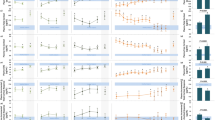Abstract
Glucocorticoids are used in an attempt to reduce brain edema secondary to head injury. Nevertheless, their usefulness remains uncertain and contradictory. In a randomized study of 24 children with severe head injury, urinary free cortisol was measured by radioimmunoassay. Twelve patients (group 1) received dexamethasone and 12 (group 2) did not. All patients were treated with a standardized regimen. In group 1 there was complete suppression of endogenous cortisol production. In group 2 free cortisol was up to 20-fold higher than under basal conditions and reached maximum values on days 1–3. Since the excretion of cortisol in urine reflects the production rate closely and is not influenced by liver function and barbiturates, the results in group 2 show that the endogenous production of steroids is an adequate reaction to severe head injury. Exogenous glucocorticoids are thus unlikely to have any more beneficial effects than endogenous cortisol.
Similar content being viewed by others
References
Andrassy RJ, Dubois T (1985) Modified injury severity scale and concurrent steroid therapy: independent correlates of negative nitrogen balance in pediatric trauma. J Pediatr Surg 20:799–802
Braakman R, Schouten JA, Blaauw-van Dishoeck M, Mindderhoud JM (1983) Megadose steroids in severe head injury. Results of a prospective double-blind clinical trial. J Neurosurg 58:326–330
Cooper P-R, Moody S, Clark WK, Kirkpatrick J, Maravilla K, Gould AL, Drane W (1979) Dexamethasone and severe head injury: a prospective double blind study. J Neurosurg 51:307–314
Dearden NM, Gibson JS, McDowall DG, Gibson RM, Cameron MM (1986) Effect of high dose dexamethasone on outcome from severe head injury. J Neurosurg 64:81–88
Galicich JH, French LA (1961) Use of dexamethasone in the treatment of cerebral edema resulting from brain tumors and brain surgery. Am Proctol 12:169–174
Saul TG, Ducker TB, Salcman M, Carro E (1981) Steroids in severe head injury: a prospective randomized clinical trial. J Neurosurg 54:596–600
Stolecke H (1970) The determination of free urinary cortisol — a modification of the method described by Gerdes and Staib and normal values in infants. Horm Metab Res 2:298–301
Author information
Authors and Affiliations
Rights and permissions
About this article
Cite this article
Klöti, J., Fanconi, S., Zachmann, M. et al. Dexamethasone therapy and cortisol excretion in severe pediatric head injury. Child's Nerv Syst 3, 103–105 (1987). https://doi.org/10.1007/BF00271134
Issue Date:
DOI: https://doi.org/10.1007/BF00271134




